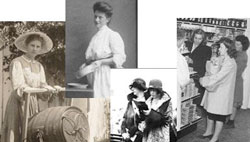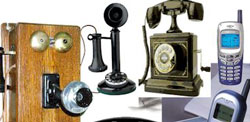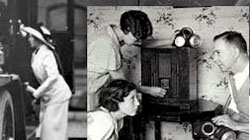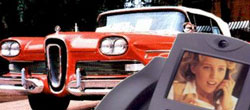The History of ‘Us’
Advances in technology and the ways we have used new technologies have changed our homes, our communities and even the landscape of our country.
Social history is the history of ‘us,’ what we do, what we think about, what matters to us. It’s the history of our society and culture.
For centuries, historians tended to define history in terms of the actions of countries and public figures. The study of history was an endless succession of dates marking major events, and analysis of why countries went to war or colonized newly discovered parts of the world.
More recently, the study of history has been expanded to encompass the lives of ordinary people. This approach, the study of social or cultural history, is characterized not so much by major events but by analyzing the slow or rapid shifts in how people lived, what they thought about and how they spent their time.
An important aspect of social history is the study of the things we use in our lives – the clothing, tools, art and personal possessions that all of use in our daily lives. Sometimes these things, referred to as material culture, are the only record we have of the lives of people in earlier civilizations.
When we study the things produced by technology it is possible to link our material culture with the concept of social history. From this perspective, it becomes possible to understand the effect of technology on culture.


Today’s Technology Has Roots in The Past
Although we have just entered a new century, virtually everything we experience today has its roots in the century just ended, the 20th century.
To understand the true impact of the introduction of household refrigeration, we have to start to look at the intimate link between technology and culture. Advances in technology are not just a matter of science, but also an intimate component of human lives. This is technology as culture.
It has been said that while civil society provides one framework for social life and the flow of meaning, our contemporary culture is now in large part defined by the forces of ‘commoditization.’ These forces are dictated and organized by the marketplace, much less than by the agencies of the state.
It is incumbent on us, then, to understand better the dictates of the marketplace, if we are to come to interpret the contemporary culture that we have created for ourselves and the impact that our technologies are having on our lives. And to understand our culture today, it is necessary to trace the roots of our technologies back into the twentieth century. There is virtually no aspect of today’s complex technological environment that did not have its roots in the twentieth century.
The telephone is an obvious example. But the same is true of almost any other technology we depend on, from transportation, to digital recording, to telecommunications, computers, architecture and many more.
Twentieth Century Social History
The social history of the 20th century can be traced by many things: the foods we ate, the clothes we wore, the leisure-time entertainment we chose.
The study of material culture gives us the tools to trace trends in social history. Not only are many of the artefacts themselves available, the advent of photography and half-tone printing have left a welter of historical images that document how we used the things that made up our material culture.
Some trends are most obvious in the design and styling of such things as clothing, hair arrangement, make-up, and jewellery. The appearance of popular styles of men’s hats distinguishes early from mid- and late-twentieth century cultures as surely as the appearance of television and computers.
Our ideas about the world changed continuously over this period as well, from the need to dominate nature, for instance, to the desire to preserve and manage it wisely. And with changing ideas inevitably goes changing human behaviour patterns.


Twentieth Century Technological Advances
Some of the strongest underlying forces that shaped our society and culture during that century were advances in technology.
An examination of patterns of change in material culture during the twentieth century quickly identifies the dominant role played by technology.
By the beginning of the century the industrial revolution had replaced the power of human labour with the power of machines. We understood how to manufacture and distribute goods, like colourful textiles and clothing, that had formerly been luxuries but were now just affordable commodities.
Theoretical and practical science were producing a knowledge of matter that gave us ever greater control. This knowledge gave rise to technologies, practical applications, that allowed the generation of electrical power, the development of wireless communication and recording images with silver grains.
We could carry out our activities as easily at night as in daytime. We could keep in touch with people half way around the world. And we could accomplish more with the flick of a switch than we had previously been able to do with a full day’s work. As the century progressed, this influence of technology on our behaviours, our lifestyles and even on our view of the world, only became more pronounced.
Continuous Improvements in Household Food Keeping
We have seen how continual improvements in the household refrigerator changed life in the home and redefined the ways we think about health, nutrition and good living.
The household refrigerator was an outstanding example of this profound influence of technology on culture. Linked as intimately as it was with food, health and nutrition, it changed people’s lives from the start.
Refrigerators gave women more time away from the kitchen and allowed them to pursue new leisure activities and eventually independent careers outside the home.
The refrigerator came to be associated with all that is modern and was as much a factor in a householder’s sense of ‘progress’ as having the latest model automobile in the driveway.
Competition between manufacturers for the large home refrigerator market ensured that new models were frequently characterized by better features. They stored more food, offered more control over internal temperatures and eventually needed less servicing.
While during the first half of the century refrigerators were often repaired and their internal components replaced one or several times, the latter half of the century saw the development of a new ethic. The appliances were now so reliable that they would run for 20 years or more without either regular maintenance or repair. When they finally broke down, they were simply discarded in favour of a newer model with better features. The refrigerator became part of a disposable, consumption oriented society.


Technologies Impact Our Lives
When you start to think about social history in this way, it’s easy to see the impact that other technologies – aviation, automotive, telephone, radio, television, computers – have had on our lives.
Looking in intimate detail at the impact of refrigerator technology on our culture can provide an informative model for understanding the role of technology in general. No matter which technology we examine, it soon becomes evident that it has had a major impact on our lives.
Among other things, computers have radically changed the way we learn and get an education, as well as the way we communicate with each other. Air travel has changed the way we vacation, and television has changed the way we spend our leisure time.
Behind the scenes of our lives, medical, agricultural and pharmaceutical technologies have reduced disease, extended our lifetimes and improved our quality of life. New industrial chemicals mean we may be wearing clothing composed entirely of artificial materials that last longer, insulate better and cost less.
Technological Advances Change Our Environment
Advances in technology, and our use of them, have changed our homes, our communities and even the landscape of our country.
The ramifications of technological change now extend well beyond our personal lives, to the very structure and fabric of our world.
Forestry and agriculture have cleared vast forested areas and transformed natural habitats from sylvan to monoculture.
Aviation criss-crosses our skies with vapour trails and blinking lights.
Instead of darkness, the surface of our planet glows with artificial light from our cities at night. In the night sky, we can no longer see the stars because of visual interference from those same lights.
Rivers have been dammed, diverted and dried up, while inland seas turn to arid salt plains. We are slowly changing significant areas of the earth’s surface into pavement and human dwellings. The chemical nature of the soil, the inland waters and even of the oceans and the air we breathe has been changed by our industrial and agricultural activities.


Technology is Not Inevitable
But although technology is a powerful force, another lesson of history is that technology is not inevitable. We still have choice – technologies that don’t meet human demands quickly die out.
The twentieth century is also a source of abundant information demonstrating that not every new technology is adopted – not even if accompanied by massive marketing efforts.
In the fall of 1957 the Ford Motor Company introduced a new luxury model. It was the 1958 Edsel, named after Edsel Ford, the only son of Henry Ford, the company’s founder. Yet the Edsel was not a success.
The Edsel was launched with plenty of advertising and advance publicity. It is reported that as many as two and a half million people flocked to showrooms and automobile shows to see it. But the model was eccentric in design, had a poor quality record, and never sold well. After three years Ford discontinued the product line, and the Edsel has been the butt of jokes for decades since. The Edsel is sometimes referred to as one of the most monumental commercial failures of the twentieth century.
The consuming public is perfectly capable of rejecting a technology that it collectively decides it doesn’t need. The Sony electronics company developed and marketed a videocassette recorder (VCR) in the early 1980s using Beta format tape cassettes. It was in competition with VHS format machines marketed by Panasonic, JVC, Hitachi and other manufacturers. Although some felt that the Beta format was technologically superior, the Beta machines and tapes eventually disappeared altogether to be replaced entirely by VHS technology. Most consumers eventually decided that it was a better strategy to purchase a machine supported by several manufacturers who competed on pricing. More pre-taped movies were available in VHS format too. Although Sony has never officially discontinued the Beta line, it is widely considered to be a failed technology.
Almost since television first became widely available in the 1950s, futurists predicted the video telephone, a device where callers could see each other while they spoke on the telephone. Apparently Bell engineers actually began working on the concept in the 1920s and by 1964 had something that worked. But picture quality was poor, the cost was high, and most telephone users didn’t want to have to prepare themselves to be ‘on camera’ every time they spoke on the phone. Although we can now use desktop computers to send streaming video with voice around the world using the internet, the video telephone still hasn’t caught on.
So we do have a choice. And the failed technologies of the twentieth century are the record of the choices we made.
Choosing Technologies Wisely
It’s up to us, then, to ensure we choose our technologies and our use of them wisely, with our own health and the health of our planet firmly in mind.
Some of the technologies we choose, like the refrigerator, make a strong positive impact on human lives. While others, like the sports-utility-vehicle (SUV) and lawn-care pesticides seem to have few positive features.
Technology is still very much under our control. But our inexorable development of new technologies seems to demand that we be alert. We need to evaluate the pros and cons of each new technology that manufacturers try to sell us.
Those technological advances that fulfill real needs and do no harm will be adopted. Those that fulfill real needs and are harmful to our planet need to be delayed until all the ‘bugs’ have been worked out. And as always, those new technologies that remain dangerous, and those that people don’t really need, will continue to fall by the wayside of social history.


